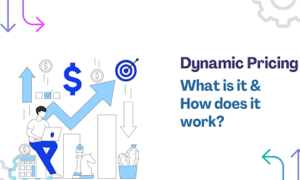In today’s fast-paced and ever-changing business landscape, one thing is certain: pricing strategies are no longer set in stone. The advent of technology, e-commerce, and global competition has given rise to a dynamic market where prices can fluctuate rapidly, and consumer preferences can shift overnight. To thrive in this dynamic market, businesses must adopt pricing strategies that are flexible, data-driven, and responsive to market changes. In this blog post, we will explore the concept of dynamic pricing and discuss various strategies that can help businesses succeed in this challenging environment.
Understanding Dynamic Pricing
Dynamic pricing is a pricing strategy that involves adjusting the price of a product or service in real-time based on various factors such as demand, competition, and market conditions. Unlike traditional pricing models that set fixed prices, dynamic pricing allows businesses to optimize their pricing to maximize revenue and profitability.
Dynamic pricing has gained prominence in recent years, thanks to advances in technology and the availability of data. With the help of sophisticated pricing algorithms and machine learning, businesses can now analyze vast amounts of data to determine the optimal price for their products or services at any given moment. This data-driven approach enables businesses to stay competitive and adapt to changing market dynamics.
Benefits of Dynamic Pricing
- Maximizing Revenue: Dynamic pricing allows businesses to charge higher prices during peak demand periods and lower prices when demand is low. This can lead to increased revenue and profitability.
- Competitive Advantage: By continuously monitoring market conditions and adjusting prices accordingly, businesses can gain a competitive edge over rivals who use static pricing models.
- Inventory Management: Dynamic pricing can also help businesses manage their inventory more effectively. By adjusting prices to clear out excess inventory or promote slow-moving products, businesses can reduce carrying costs and improve cash flow.
- Customer Segmentation: Dynamic pricing allows businesses to segment their customer base and offer personalized pricing to different customer groups. This can enhance customer loyalty and satisfaction.
Dynamic Pricing Strategies
Now that we understand the importance of dynamic pricing, let’s delve into some effective strategies that businesses can employ to succeed in a dynamic market:
- Demand-Based Pricing: This strategy involves adjusting prices based on demand levels. When demand is high, prices can be increased, and when demand is low, prices can be lowered to attract more customers.
- Competitor-Based Pricing: Businesses can monitor their competitors’ prices and adjust their own prices accordingly. This strategy helps maintain price competitiveness in the market.
- Time-Based Pricing: Pricing can be varied based on the time of day, week, or year. For example, hotels often charge higher rates during peak tourist seasons and lower rates during off-peak periods.
- Segmented Pricing: Different customer segments may be willing to pay different prices for the same product or service. By segmenting customers based on factors such as demographics, location, or purchase history, businesses can offer tailored pricing.
- Dynamic Discounts: Offering discounts and promotions based on real-time data can attract price-sensitive customers and boost sales during slow periods.
- Subscription Models: Subscription-based pricing can provide a steady stream of revenue while offering customers the convenience of regular access to products or services.
- Geographic Pricing: Prices can be adjusted based on the location of the customer. This is particularly useful in global markets where purchasing power and consumer preferences vary by region.
- A/B Testing: Businesses can conduct A/B tests to determine the optimal pricing strategy for a particular product or service. This involves randomly assigning different prices to different groups of customers and analyzing the results.
- Data Analysis: Employing advanced data analytics and machine learning algorithms to analyze customer behavior and market trends can provide valuable insights for dynamic pricing decisions.
Challenges of Dynamic Pricing
While dynamic pricing offers numerous benefits, it also comes with its own set of challenges and potential pitfalls. Some of these challenges include:
- Consumer Perception: Rapid price changes can lead to consumer mistrust and backlash. Businesses must communicate their pricing strategies transparently to avoid negative perceptions.
- Competitive Response: Competitors may quickly respond to price changes, leading to price wars that can erode profitability.
- Data Accuracy: Dynamic pricing relies heavily on accurate and up-to-date data. Inaccurate data can lead to suboptimal pricing decisions.
- Legal and Ethical Concerns: Some industries and jurisdictions have regulations that restrict the use of dynamic pricing, especially when it comes to price discrimination or price gouging.
Conclusion
In a dynamic market, where consumer preferences, market conditions, and competition are constantly changing, static pricing strategies are no longer sufficient. Businesses must embrace dynamic pricing to stay competitive and maximize their revenue. By employing data-driven strategies, monitoring market conditions, and adapting pricing in real-time, businesses can thrive in the face of uncertainty and enjoy sustained success in today’s dynamic market.
Dynamic pricing is not a one-size-fits-all solution, and businesses should carefully consider their industry, target audience, and product or service offering when implementing dynamic pricing strategies. Additionally, businesses should always prioritize transparency and ethical considerations to maintain consumer trust and loyalty.



































